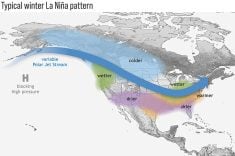After a decade of discussion and failed attempts, Canada finally has a national standard for organic agriculture.
A committee selected by the Canadian General Standards Board developed the standard, which was recently ratified by the national standards council. Canada is the first nation to have a national standard in place.
“The organic standards are a basic blueprint in order to achieve organic consistency of product across Canada,” said Ken Dyck, secretary of the Canadian Organic Advisory Board Inc., a group set up to establish an industry-driven standard after a government attempt to devise an organic standard flopped in 1995.
Read Also

Saskatchewan throne speech promises strong economy
Saskatchewan’s legislative agenda for the coming year will focus on meeting the challenges of new world trading relationships, said the speech from the throne.
The new national standard addresses the production, processing and labeling of organic product. The 25-page document is specific, even including a paragraph on how to breed and select honeybee queens. But it can be boiled down to some basic principles, said Dyck.
All of a grower’s fields will be checked by a qualified inspector once a year, before harvest. A uniform inspection report will be completed and submitted to COAB for final approval.
Organic processors will also be inspected once a year to ensure they are maintaining proper audit trail so no non-organic product is mixed with organic product throughout the process.
There is a five percent allowance for non-organic material built into the standard. This provision was included because some animal feed mixes require small amounts of non-organic material, said Dyck. Processors who use this allowance must stipulate it on the product label.
Dyck said the new national standards are in place, but consumers won’t be seeing products with the “Canada Organic” label for another month or two while COAB tries to finalize a certification process for the new standards.
Meanwhile, COAB has applied for accreditation with the European Trade Commission. It hopes this will give Canadian producers a toe-hold on the vast European market for organic goods.
“This is where (the new standard) is really going to help the Canadian producer,” said Dyck.
In the past, containers full of Canadian organic wheat and flax have been held up and even sent back by European countries such as England, Denmark and Greece, which are getting fussier about products meeting strict standards.
If the new national standard is accredited by the European Union, Canadian producers could gain a competitive advantage over their American counterparts.















